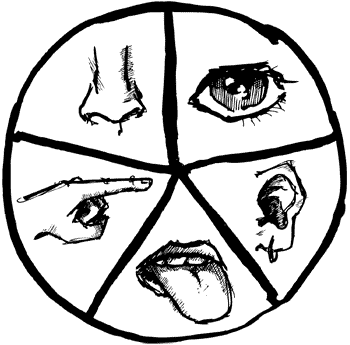People with AS already notice little things more than the average person - a vent or someone tapping a pencil in class can be more distracting than if a full parade marched through the room! Having your senses muddled up just makes the problem worse since the brain can't properly interpret input.
The part which confuses me about all of this is how senses can simultaneously be too high and too low. My sense of touch seems that way sometimes. Light touches drive me nuts - someone bumping slightly against me or a hand brushing across my back will drive me up a wall. In the same breath, heavy pressure from blankets or hugs relaxes me and creates a feeling of safety. However, this is a hugely common problem in autism.
When I was in a classroom for kids with Asperger's Syndrome, it was a mess with all the sensory differences. One kid would be blasting music in their headphones which would cause another to become upset since they could hear the tiny bit of music and it ruined their concentration. One would do nothing but play with Lego blocks while another couldn't stand the feel of the bumps on them.
Because of all the sensory issues people with AS tend to have, stimming is important. It regulates the senses, allowing an individual to change the input and process it better. It also provides relief from emotional stress. I know that when I get upset over something I seek stimuli like crazy, tapping, bouncing, humming or tensing muscle groups. There's probably some neurology behind this that I'm not aware of, but for one reason or another, it helps.
 While stimming is important, it can be hard to explain as you get older. I've learned to confine my stimming more in college. A simple thing like wiggling a finger in a button hole on my jacket or tapping my toes can pass properly and isn't as offputting to others as full body bouncing or swaying.
While stimming is important, it can be hard to explain as you get older. I've learned to confine my stimming more in college. A simple thing like wiggling a finger in a button hole on my jacket or tapping my toes can pass properly and isn't as offputting to others as full body bouncing or swaying.Patience and pushing myself bit by bit has been amazingly successful in overcoming most of my sensory issues. When I feel myself starting to cringe because of a texture, I'll force myself to touch it just to realize that it isn't that bad. High-pitched sounds can drive me up a wall, so I remember to take a deep breath and figure out how to either remove myself from the area or stop the sound.
The more self-aware you are, the better you can overcome the sensory issues. It's important to not only learn to stand them but to work every day on improving your reaction to them through little things like touching something you dislike or tasting a food that is a bit unpleasant.
How have you learned to control your or your child's need to stim on things? What kinds of toys or methods have worked?

No comments:
Post a Comment